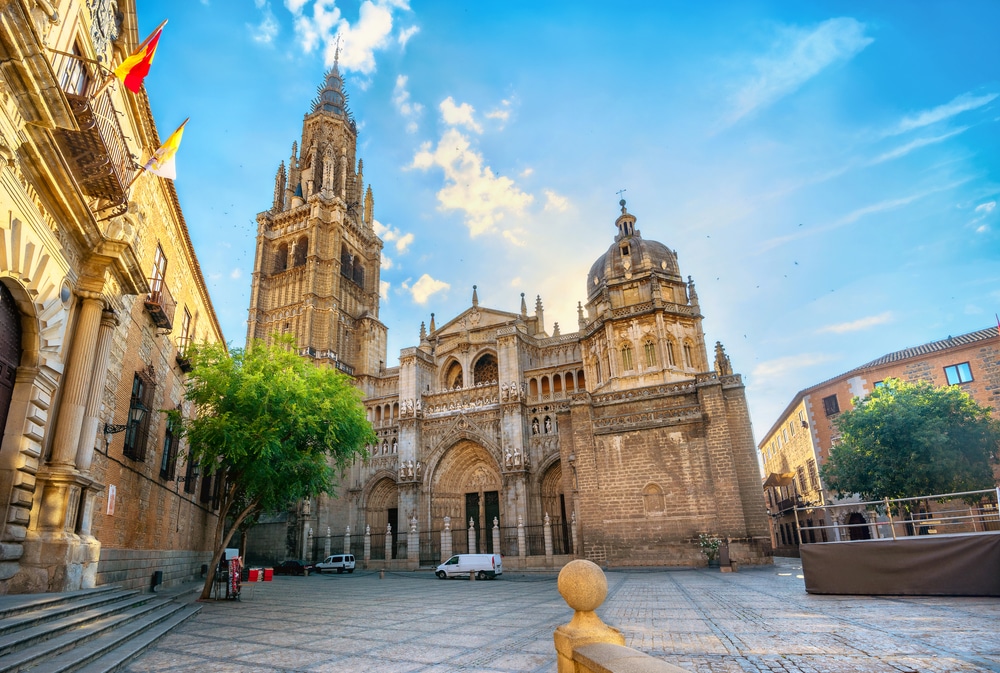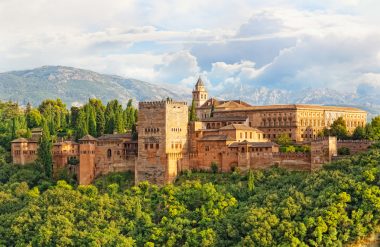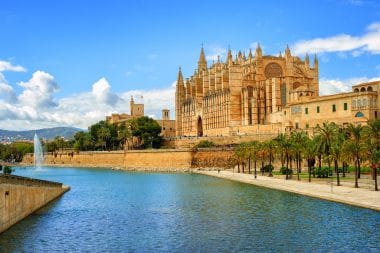
Spain is one of the most popular travel destinations for Germans. In addition to the Balearic Islands and Canary Islands, the country also has some great destinations to offer on the mainland. Below you will find a selection of the most popular sights in Spain.
Sagrada Familia in Barcelona

Barcelona is one of the top destinations in Spain. The capital of Catalonia has two of the most visited sights in the country, the Sagrada Familia and the Parc Güell. The Sagrada Familia remains unfinished to this day and represents the main work of Antoni Gaudí in the style of Modernisme, the Catalan form of Art Nouveau. The “Sermon of Stone” fascinates with its differently designed facades and towers as well as the light-flooded interior. Gaudí was inspired by motifs from nature during the construction and most recently lived on the construction site itself.
Alhambra in Granada

The Alhambra towers high above Granada as a landmark and symbol of Andalusia’s Moorish heritage. For centuries, it was the seat of the Moorish Caliphate in the south of today’s Spain. The Alhambra complex is made up of the Generalife, the summer palace outside the fortress walls, the medina, the Nasrid palaces and the Alcazaba, i.e. the citadel. The most famous part, however, is the Löwenhof with the Löwenbrunnen. Later, the palace of Charles V was added, for which parts of the Nasrid palaces were demolished. With the construction of the Alhambra in the 13. and It began in the 14th century under the first Nasrid sultan, but the origins of the castle go back even further.
Insider tip: Camino del Rey in Andalusia
Camino del Rey, Andalusia – The former via ferrata is now a secured hiking trail and leads at a height of 100 meters through gorges up to 200 meters deep. On the way you pass a narrow stone bridge and a waterfall. Due to the restoration, the via ferrata has largely lost its original character, but is now safe to walk on after prior registration. The Camino del Rey once served as a small supply route and connected the weir on the Gaitanejo with the hydroelectric power plant at the El Chorro waterfall. The canyon through which the path winds was created by the Guadalhorce River and passes through limestone and dolomite rock.
Royal Palace in Madrid

A representative symbol of power in the centre of the Spanish capital is the imposing Royal Palace, the largest of its kind in Europe. It comprises about 2000 halls, rooms and cabinets, but a total of more than 3400 rooms on an area of 135,000 square meters. Several architectural styles, including Baroque and Classicism, meet in the interior. Among the most important interiors are the State Room, the Gallery of Mirrors and the Throne Room. Nor is there a richly decorated castle chapel. Parts of the Palacio Real are open to visitors.
Toledo Cathedral
Toledo Cathedral is one of the largest and most beautiful churches in Spain. As is so often the case, it was built over a mosque. The foundation stone was laid in 1226. In total, the completion took over 200 years. Inside, the artistically designed and filigree main altar attracts everyone’s attention. No less impressive is the choir stalls with organ.
Cathedral of Palma de Mallorca

The cathedral of Palma attracts countless visitors due to the unbridled popularity of Mallorca as a holiday island. Parts of the cathedral were designed by Antoni Gaudí. Inside, the unique lighting conditions that originate from the 61 stained glass windows are particularly fascinating. In addition, there are the rosettes at both ends of the nave. At Candlemas in February and on St. Martin’s Day in November, the rising sun shines directly through the rose window on the east side and is reflected on the opposite side. From the terraces on the roof of the cathedral, the rose windows can be inspected more closely. From here, the view sweeps far over the old town and bay of Palma.
Seville Cathedral with Giralda
Seville, the capital of Andalusia, ranks high among the most popular city destinations in Spain with its cathedral and old town. The Giralda, the tower of the immense Gothic cathedral, even became the landmark of the Andalusian metropolis. The high altar with altarpiece is covered all over with gold, but the chapels and frescoes in the cathedral are also worth seeing. The largest altarpiece in the world was built between 1482 and 1564 and measures 20 by 23 meters.
Mezquita of Córdoba
The Mezquita of Córdoba, which is one of the largest sacred buildings in the world, resembles an impenetrable forest of columns. In the 16th century, a Gothic nave was built into the huge mosque and the minaret was replaced by a bell tower. The Mezquita was the main mosque in Moorish Spain and has a floor area of 23,000 m². Construction began in the eighth century. In 1984, it was included in the UNESCO World Heritage List, along with the old town of Córdoba.
San Lorenzo de El Escorial near Madrid
Not far from Madrid , in the middle of the Sierra de Guadarrama, the famous palace and monastery complex rises as the largest Renaissance building in the world. The facades are surprisingly simple for such a symbol of power. Inside, there are 200 chambers, 3000 doors and 2673 windows, as well as 16 courtyards, 12 cloisters and 88 fountains. The historic library hall in particular is worth a longer look. In the Pantheon of Kings with several chapels, numerous Spanish kings and their entourage were buried.
Santiago
The Way of St. James, the most famous pilgrimage route, leads over a good 800 kilometers through northern Spain from the Pyrenees to Santiago de Compostela. On the way, you will pass such well-known cities as Pamplona, Burgos and León, but also magnificent natural landscapes. Every year, thousands of pilgrims walk the main route of the Camino de Santiago and spend the night in the pilgrims’ hostels that are provided. The current route was created during the 11th century and is signposted by the symbol of the scallop shell.

